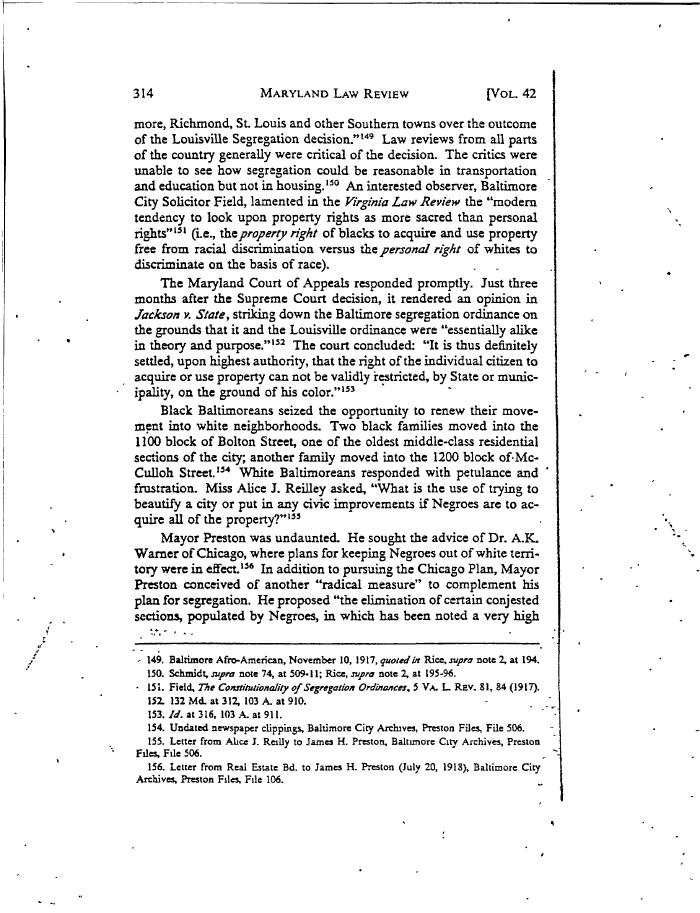 |
||||
|
Garrett Power, Apartheid Baltimore Style: The Residential Segregation Ordinances of 1910-1913, Maryland Law Review, 42 (1983) , Image No: 27 Enlarge and print image (61K) << PREVIOUS NEXT >> |
 |
||||
|
Garrett Power, Apartheid Baltimore Style: The Residential Segregation Ordinances of 1910-1913, Maryland Law Review, 42 (1983) , Image No: 27 Enlarge and print image (61K) << PREVIOUS NEXT >> |
| 314 MARYLAND LAW REVIEW [VOL. 42 more, Richmond, St. Louis and other Southern towns over the outcome of the Louisville Segregation decision.149 Law reviews from all parts of the country generally were critical of the decision. The critics were unable to see how segregation could be reasonable in transportation and education but not in housing.150 An interested observer, Baltimore City Solicitor Field, lamented in the Virginia Law Review the "modern tendency to look upon property rights as more sacred than personal rights151 (i.e., the property right of blacks to acquire and use property free from racial discrimination versus the personal right of whites to discriminate on the basis of race). The Maryland Court of Appeals responded promptly. Just three months after the Supreme Court decision, it rendered an opinion in Jackson v. State t striking down the Baltimore segregation ordinance on the grounds that it and the Louisville ordinance were "essentially alike in theory and purpose.152 The court concluded; "It is thus definitely settled, upon highest authority, that the right of the individual citizen to acquire or use property can not be validly restricted, by State or munic- ipality, on the ground of his color.153 Black Baltimoreans seized the opportunity to renew their move- ment into white neighborhoods. Two black families moved into the 1100 block of Bolton Street, one of the oldest middle-class residential sections of the city; another family moved into the 1200 block of Mc- Culloh Street.154 White Baltimoreans responded with petulance and frustration. Miss Alice J. Reilley asked, "What is the use of trying to beautify a city or put in any civic improvements if Negroes are to ac- quire all of the property?155 Mayor Preston was undaunted. He sought the advice of Dr. A.K. Warner of Chicago, where plans for keeping Negroes out of white terri- tory were in effect.156 In addition to pursuing the Chicago Plan, Mayor Preston conceived of another "radical measure" to complement his plan for segregation. He proposed "the elimination of certain conjested sections, populated by Negroes, in which has been noted a very high 149. Baltimore Afro-American, November 10, 1917, quoted in Rice, supra note 2, at 194. I50. Schmidt, supra note 74, ai 509-11; Rice, supra note 2, at 195-96. 151. Field, The Constitutionality of Segregation Ordinances, 5 VA. I_ REV. 81, 84 (1917). 152. 132 Md. at 312, 103 A. at 910. 153. Id. at 316. 103 A. at 911. ' 154. Undated newspaper clippings, Baltimore City Archives, Preston Files, File 506. 155. Letter from Alice J. Reilly to James H. Preston, Baltimore City Archives, Preston Files, File 506. 156. Letter from Real Estate Bd. to James H. Preston (July 20, 1918), Baltimore City Archives, Preston Files, File 106. |